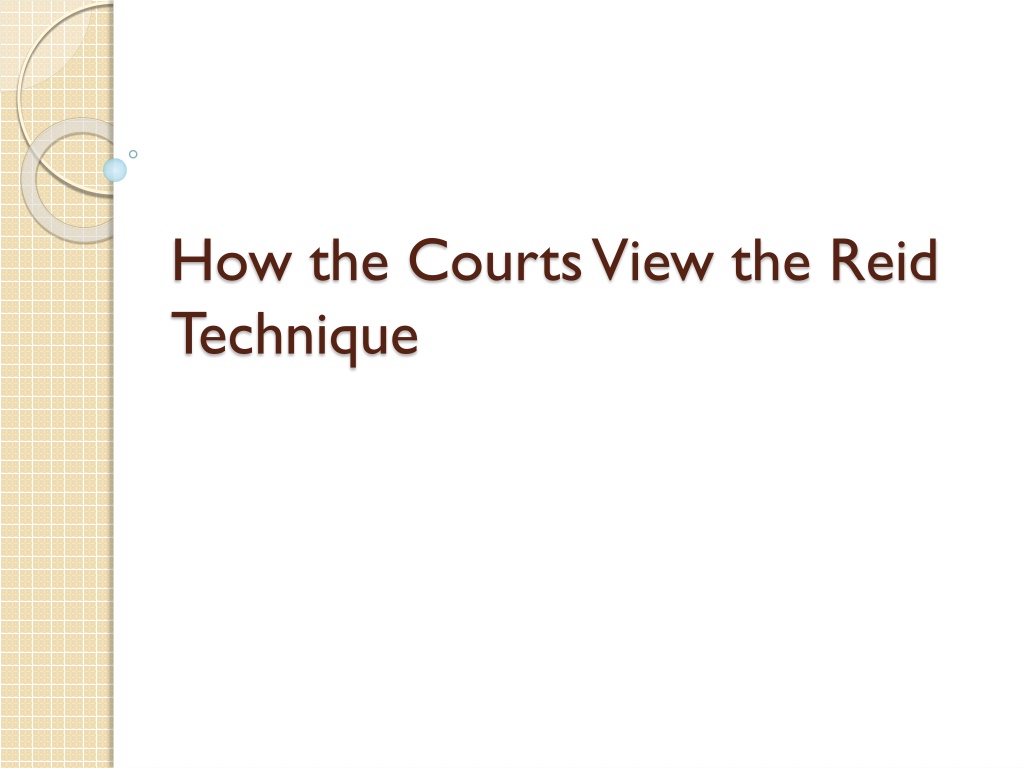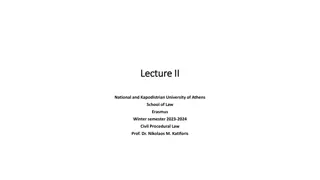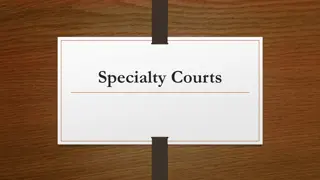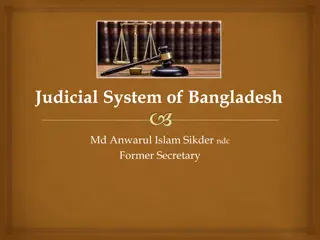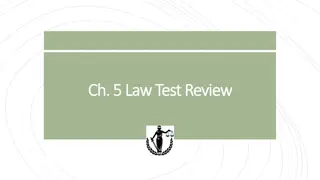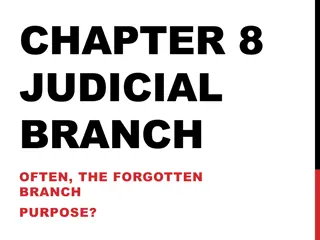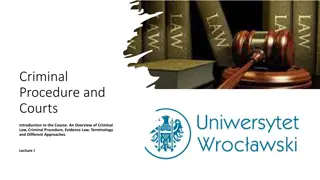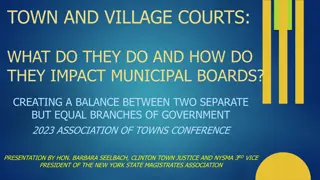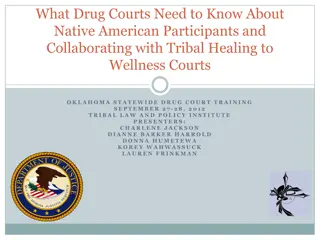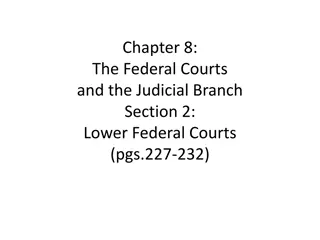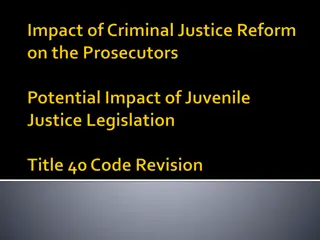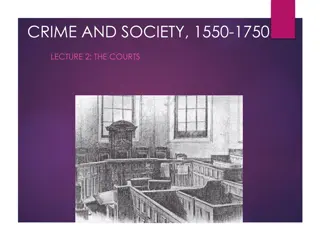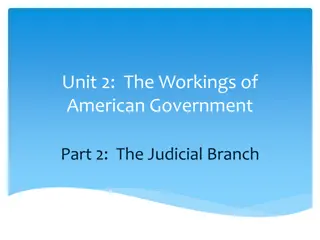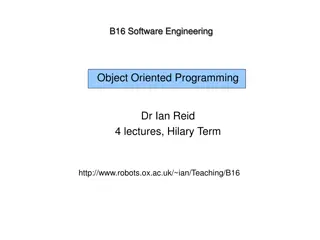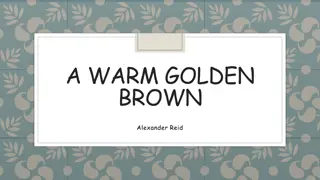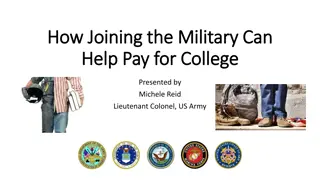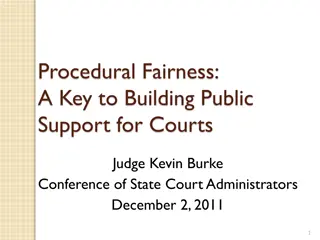Understanding the Courts' Perspective on the Reid Technique
The Courts' view on the Reid Technique emphasizes following established guidelines, avoiding coercion, and treating subjects with respect. They caution against making promises or threats, denying rights, or conducting excessively long interrogations. The core principles include conducting interviews according to court guidelines, treating subjects with dignity, and being cautious with vulnerable individuals. The Reid Technique comprises three phases, starting with Fact Analysis to identify potential interview subjects.
Download Presentation

Please find below an Image/Link to download the presentation.
The content on the website is provided AS IS for your information and personal use only. It may not be sold, licensed, or shared on other websites without obtaining consent from the author. Download presentation by click this link. If you encounter any issues during the download, it is possible that the publisher has removed the file from their server.
E N D
Presentation Transcript
How the Courts View the Reid Technique
How the Courts View the Reid Technique: Program Content Core principles of the Reid Technique What is the Reid Technique? How the Courts View Minimization
How Courts View the Reid Technique: Program Content How the Courts View Misrepresenting Evidence to the Suspect How the Courts View Being Friendly and Empathetic with the Suspect How the Courts View the Alternative Question
How Courts View the Reid Technique: Program Content Several Courts have Admonished Investigators for Not Following Reid Guidelines Federal Court - No Basis for the Claim that the Reid Technique is coercive False Confession Expert Testimony About the Coercive Nature of the Reid Technique is Rejected Reid as the Gold Standard
Core Principles Always conduct interviews and interrogations in accordance with the guidelines established by the courts Do not make any promises of leniency Do not threaten the subject with any physical harm or inevitable consequences
Core Principles Do not deny the subject any of their rights Do not deny the subject the opportunity to satisfy their physical needs Always treat the subject with dignity and respect
Core Principles Do not conduct excessively long interrogations Exercise caution when interrogating juveniles, suspects with a lower intelligence or suspects with mental impairments
What is the Reid Technique? The Reid Technique consists of a three- phase process beginning with Fact Analysis Fact Analysis involves reviewing the case evidence and facts to determine possible subjects to be interviewed;
What is the Reid Technique? The possible motive for the commission of the crime; Whether or not the perpetrator needed any special knowledge or access; The possible presence of any evidence implicating an individual person, etc.
What is the Reid Technique? Fact Analysis is followed by conducting interviews of the victim, witnesses and possible suspects The investigative interview structure in the Reid Technique is called the Behavior Analysis Interview
What is the Reid Technique? The Behavior Analysis Interview is a non- accusatory interview in which the investigator maintains a neutral and objective fact finder role The purpose of the interview is to develop behavioral and investigative information This process is essentially what is called the PEACE model in Great Britain
What is the Reid Technique? If the case evidence, facts and information developed during the investigation and the interview indicate that the subject committed the crime or is withholding relevant information, then the subject is interrogated
What is the Reid Technique? In the Reid Technique the core element of the interrogation process is called theme development in which the investigator offers the subject reasons and excuses that serve to psychologically justify the subject s behavior
What is the Reid Technique? These reasons and face-saving excuses for the subject's crime include projecting blame away from the subject on to such elements as financial pressure, the victim's behavior, an accomplice, emotions, or alcohol.
What is the Reid Technique? False confession experts oftentimes refer to this process as minimization And suggest that minimization is tantamount to a promise of leniency
How the Courts View Minimization There are two types of acceptable minimization that can occur during theme development: minimizing the moral seriousness of the behavior minimizing the psychological consequences of the behavior We teach never to minimize the legal consequences of the suspect s behavior
How the Courts View Minimization In the White Paper written for the American Psychology-Law Society entitled, Police-induced confessions: Risk factors and recommendations (Law and Human Behavior 2010) the authors - Saul Kassin, Steven Drizin, Thomas Grisso, Gisli Gudjonsson, Richard Leo and Allison Redlich - agree with us
How the Courts View Minimization Stating that future recommendations for interrogation procedures should permit moral and psychological forms of minimization, but ban legal minimization.
How the Courts View Minimization Hayes v. Plumley death of an 18 month old child The detectives presented the subject s predicament in terms of two options: he could either continue to feign ignorance and, from his silence, be treated as a remorseless killer, or otherwise confess to an accident resulting from a brief fit of rage or lapse in judgment and receive mercy. Confession admissible
How the Courts View Minimization State v. Fouts sexual abuse of a minor The other possible statements in the record that arguably minimized Fouts's offense were the officer's statement that she believed he made a mistake and mistakes can be fixed , and her characterization of what might have happened the night before as iffy. However, we find nothing about those vague and indefinite statements that would render his confession involuntary.
How the Courts View Minimization Williams v. State homicide Police officer's implication that defendant might see the outside again if he confessed to a robbery gone bad instead of a premeditated murder was not an inducement rendering his confession involuntary
How the Courts View Minimization Fundaro v. Curtin homicide The officers merely informed defendant that if what he did was self-defense then it was in his best interests to say so. While Petitioner testified that he understood the officers to be saying that he did nothing wrong, their testimony shows that they made no such representation. Confession admissible
How the Courts View Minimization US v. Hunter death of a 9 year old child While Agent David's repeated assurances that she understood how Hunter must have felt and that she (Agent David) believed the incident was an accident were no doubt persuasive and inducing, nothing in those statements constitutes a quid pro quo promise to Hunter in exchange for a confession. Confession admissible
How the Courts View Minimization The courts consistently reject the claim from defendants that the investigator s suggestion that the crime was an accident is a coercive tactic: Smith v. State State v. Turner Walker v. Davis US v. Hunter State v. Fundaro
How the Courts View Minimization Commonwealth v. Johnson People v. Carrillo-Garcia People v. Batiste People v. Carrington People v. Wroten Bramley v. State People v. Holloway
How the Courts View Minimization People v. Flores homicide "This is your opportunity to tell the truth ... 'cause if you were with somebody and they did something stupid that you didn't know about, that's on them. Let them deal with that but don't make this about you by lying about it because you're only, not only trying to help yourself, you're trying to help the other person " Confession admissible
How the Courts View Minimization Thlang v. Jacquez homicide The Court rejected the defendant's claim that his statements after the detective urged him to be a witness rather than a suspect were involuntary and inadmissible because this was an implied promise of benefit or leniency which induced him to admit he was present at the shooting
How the Courts View Minimization R v. Oickle Canada Supreme Court "There is nothing problematic or objectionable about police, when questioning suspects, in downplaying or minimizing the moral culpability of their alleged criminal activity. I find there was nothing improper in these and other similar transcript examples where [the detective] minimized [the accused s] moral responsibility.
How the Courts View Minimization State v. Belonga [Investigator] testified that he used an interrogation technique that involves "minimizing the actions [of defendants to suggest] that they are less culpable for their actions, whether it be due to a chemical dependence or being under the influence of alcohol or drugs or being [under] the stress of a single parent. Given that police are permitted to mislead a suspect, they are likewise permitted to use minimization techniques."
How the Courts View Minimization People v. Harrington suggestions that the ... homicide might have been an accident, a self-defensive reaction, or the product of fear, were not coercive; they merely suggested possible explanations of the events and offered defendant an opportunity to provide the details of the crime. This tactic is permissible.
How the Courts View Minimization State v. Fundaro rationalizing a defendant's actions (self- defense/accident) in such a way that he "might hope that he would not be charged with murder" did not render the confession inadmissible
How the Courts View Misrepresenting Evidence to the Suspect False confession experts oftentimes testify that misrepresenting evidence to a suspect is coercive Generally speaking the courts do not find misrepresenting evidence to be a coercive tactic
How the Courts View Misrepresenting Evidence to the Suspect Frazier v. Cupp United States Supreme Court Upheld a defendant s confession that was the result of the police falsely telling the subject that his accomplice had confessed, implicating him in the commission of the crime. In their opinion, the Supreme Court stated that the totality of circumstances must be considered in determining the voluntariness of a confession
How the Courts View Misrepresenting Evidence to the Suspect Valle v. Butler Court found confession was voluntarily given even though the police lied to the suspect about the victim being a federal informant; that his friends named him as the shooter; and that they had a recording of him bragging about the shooting
How the Courts View Misrepresenting Evidence to the Suspect Lying about DNA evidence is not coercive Demarest v. Secty, Dept of Corrections Melendez v. Koehn Jefferson v. State State v. Smith Mata v. Martel
How the Courts View Misrepresenting Evidence to the Suspect However, creating false documents purporting to be the official results of a state-police lab s DNA examination was coercive Gray v. Commonwealth
How the Courts View Misrepresenting Evidence to the Suspect Intrinsic falsehoods do not create a coerced confession Marquez v. State This court has distinguished between intrinsic falsehoods and extrinsic falsehoods.... Intrinsic falsehoods imply the existence of implicating evidence and are more likely to secure a truthful confession from a defendant....
How the Courts View Misrepresenting Evidence to the Suspect Marquez v. State continued Extrinsic falsehoods involve issues that are collateral to the crime and are more likely to overbear a defendant's will and secure a false confession or "a confession regardless of guilt." (concluding that a confession was coerced when police threatened a defendant that "state financial aid for her infant children would be cut off, and her children taken from her, if she did not 'cooperate" ')
How the Courts View Misrepresenting Evidence to the Suspect Falsely telling a suspect that a witness placed him inside of the victim s car was not coercive State v. Bates Falsely telling a suspect that a gunshot residue test and statements from witnesses identified him as the shooter were not coercive People v. Boner
How the Courts View Misrepresenting Evidence to the Suspect US v. Hunter .. courts have held that "trickery or deceit is only prohibited to the extent it deprives the suspect of knowledge essential to his ability to understand the nature of his rights and the consequences of abandoning them." Thus, "[t]he kinds of deception that are generally deemed to trigger suppression are lies about a defendant's legal rights ( i.e ., 'you must answer our questions'), false promises ( i.e., 'whatever you say will be just between us'), or threats ( i.e., 'if you don't talk, you won't see your family for a very long time') ."
How the Courts View Misrepresenting Evidence to the Suspect US v. Hunter continued Additionally, the law in the Eleventh Circuit "is clear, that the police's use of a trick alone will not render a confession involuntary," unless there are "other aggravating circumstances" beyond the mere use of deceptive tactics
How the Courts View Misrepresenting Evidence to the Suspect Along these same lines: US v. Graham misrepresenting evidence is "one factor to consider among the totality of the circumstances in determining voluntariness." ... However, "[c]ourts have been reluctant to deem trickery by the police a basis for excluding a confession on the ground that the tricks made the confession coerced and thus involuntary."
How the Courts View Misrepresenting Evidence to the Suspect US v. Graham continued The court points out that there are a number of cases in which statements elicited from a defendant in response to police deception were found involuntary,.... but "these cases all involve significant aggravating circumstances not present here, such as, subjecting the accused to an exhaustingly long interrogation, the application of physical force or the threat to do so, or the making of a promise that induces a confession."
How the Courts View Misrepresenting Evidence to the Suspect People v. Riley Not coercive to lie about having an incriminating surveillance video
How the Courts View Misrepresenting Evidence to the Suspect US v. Freeman Not coercive to lie about having a witness and finding the suspect s fingerprints at the scene of the crime
How the Courts View Misrepresenting Evidence to the Suspect People v. Smith California Supreme Court It was not coercive for the police to administer a Neutron Proton Negligence Intelligence Test that purportedly showed the defendant had recently fired a gun
How the Courts View Misrepresenting Evidence to the Suspect People v. Mays The court found that a mock polygraph test administered to defendant after he requested a lie detector test during detective's questioning, and fake test results, did not render involuntary defendant's incriminating statement, after he received the fake test results."
How the Courts View Misrepresenting Evidence to the Suspect People v. Chutan: "Police trickery that occurs in the process of a criminal interrogation does not, by itself, render a confession involuntary and violate the state or federal due process clause. Why? Because subterfuge is not necessarily coercive in nature. And unless the police engage in conduct which coerces a suspect into confessing, no finding of involuntariness can be made.
How the Courts View Misrepresenting Evidence to the Suspect People v. Chutan continued: So long as a police officer's misrepresentations or omissions are not of a kind likely to produce a false confession, confessions prompted by deception are admissible in evidence . Police officers are thus at liberty to utilize deceptive stratagems to trick a guilty person into confessing. The cases from California and federal courts validating such tactics are legion.
How the Courts View Being Friendly and Empathetic with the Suspect In the Reid Technique we teach that the investigator should be understanding and empathetic with the subject Some critic s have suggested that this is misleading and coercive
